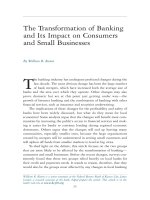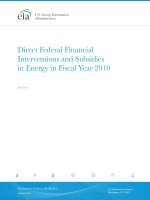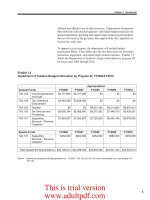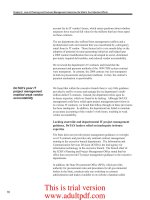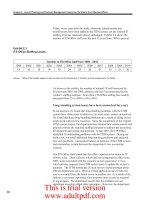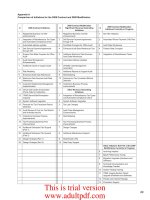Australian School of Business School of Banking and Finance FINS5541 ADVANCED INVESTMENT AND FUNDS MANAGEMENT COURSE OUTLINE SEMESTER 1, 2010 pot
Bạn đang xem bản rút gọn của tài liệu. Xem và tải ngay bản đầy đủ của tài liệu tại đây (47.26 KB, 12 trang )
[FINS5541 – Advanced Investment and Funds Management]
1
Australian School of Business
School of Banking and Finance
FINS5541
ADVANCED INVESTMENT AND FUNDS MANAGEMENT
COURSE OUTLINE
SEMESTER 1, 2010
[FINS5541 – Advanced Investment and Funds Management]
2
TABLE OF CONTENTS
1. STAFF CONTACT DETAILS 2
2. COURSE DETAILS 3
2.1 Teaching Times and Locations 3
2.2 Units of Credit 3
2.3 Summary of Course 3
2.4 Course Aims and Relationship to Other Courses 3
2.5 Student Learning Outcomes 5
3. LEARNING AND TEACHING ACTIVITIES 5
3.1 Approach to Learning and Teaching in the Course 5
3.2 Learning Activities and Teaching Strategies Error! Bookmark not
defined.Error! Bookmark not defined.
4. ASSESSMENT 6
4.1 Formal Requirements 6
4.2 Assessment Details 6
4.3 Assessment Format 7
4.4 Assignment Submission Procedure 7
4.5 Late Submission 7
5. ACADEMIC HONESTY AND PLAGIARISM 7
6. COURSE RESOURCES 7
7. COURSE EVALUATION AND DEVELOPMENT 9
8. STUDENT RESPONSIBILITIES AND CONDUCT 10
8.1 Workload 10
8.2 Attendance 10
8.3 Special Consideration and Supplementary Examinations 10
8.4 General Conduct and Behaviour 11
8.5 Occupational Health and Safety 11
8.6 Keeping Informed 11
9. ADDITIONAL STUDENT RESOURCES AND SUPPORT 11
10. COURSE SCHEDULE 12
[FINS5541 – Advanced Investment and Funds Management]
3
1. Staff Contact Details
Coordinator: VT Alaganar
Office: Room 349, ASB Building
Telephone: 9385-5856
E-mail: ;
Consultation time: Monday 5:15-5:55 pm or by appointment
The preferred communication with the course coordinator is via email.
2. Course Details
2.1 Teaching Times and Locations
Monday 18:00 – 21:00; Webster 256 (K-G14-256)
Computer Lab Meetings (See schedule in Section 10) QUAD 1031
2.2 Units of Credit
This course has six units of credit and three contact hours per week.
2.3 Summary of Course
This course is one the two main offerings for the funds management
specialisation in the MCOM program. This course develops both theoretical
and practical knowledge in the area of funds management focussing on
advanced techniques in asset management and evaluation of investment
performance. Moreover, we will review the most recent research on topics such
as hedge funds, private equity, and alternative investments.
2.4 Course Aims and Relationship to Other Courses
This course is one the two main offerings for the funds management
specialisation in the MCOM program.
This course builds upon the foundation laid down by FINS5517. It requires
knowledge of derivative securities e.g. FINS5535. As in any modern investment
topic to understand the issues involved a fair amount of analytical skill is
required. For example, the participants should have basic mathematical ability
in dealing with algebraic manipulation and some understanding of calculus.
Also, the participants should be familiar with Excel since all assignments would
require the use of Excel.
Successful portfolio management requires the development of a broad array of
quantitative and qualitative skills, involving an analysis of both the investment
instruments available in the capital market and the objectives and constraints of
the ultimate investor. The purpose of this course is to acquaint the student with
[FINS5541 – Advanced Investment and Funds Management]
4
conventional and state-of-the-art tools currently employed in the asset
management industry.
[FINS5541 – Advanced Investment and Funds Management]
5
2.5 Student Learning Outcomes
By the end of this course you will have a working knowledge of:
a. Managing a pension fund’s liability with a suitable investment in a bond
portfolio,
b. Hedging interest rate risk of a fixed income portfolio,
c. Various components of collateralized mortgage securities,
d. Structuring a portfolio with long time horizon in mind,
e. Decision making in large scale real asset investment,
f. Investment styles in mutual funds and hedge funds.
g. Building a stock selection model using credit risk measures
h. How endowment funds are managed
i. Evaluating the performance of investment strategies
3. Learning and Teaching activities
3.1 Approach to Learning and Teaching in the Course
This course consists of weekly three hour sessions. Besides explaining the
topic/readings of the week, at least 45 minutes will be set aside for interactive
discussions of the week’s topic plus any relevant topics the students bring to
the class.
As and when appropriate the practice problems would be solved in the class
with the students’ input. All these would require the students to pre-read the
topic material before attending the class.
The students are encouraged to ask questions as the lecture proceeds. This is
a natural way to provide continuous feedback in the learning process.
There are two assignments. First assignment will be on “Credit Risk Modelling
and Equity Return prediction” which will be due for submission during the first
class meeting after the mid-semester recess on April 23, 2009. The second
assignment is due at the end of the session on June 4, 2009 which will be titled,
“Market Timing Techniques applied to Equity Investing’. A handout with details
and required basic data for the two projects will be handed out in class.
3.2 Learning Activities and Teaching Strategies
a. Active class participation is encouraged. Discussions may cover any
relevant topic of interest,
b. Exercises and examples are selected such that these represent typical real
life problems,
c. Sufficient practice problems are provided (without solutions) and the
solutions would be worked out by class participation,
d. Pre-reading of topics: Although the students may not understand all the
concepts in the lecture notes, the familiarity with the subject matter helps
progress faster in the class,
[FINS5541 – Advanced Investment and Funds Management]
6
e. Since investment climate is driven by the underlying economic fundamentals,
we will endeavour to point out such emerging dynamics and how these might
affect investment decisions,
f. Individual assignments: The assignments would require the student to deal
with a topic that is not discussed in the class but is a related one. This will
help the student to develop self sufficiency in analysing practical problems
and this simulates the condition under which a typical investment analyst
would work in the industry.
g. Four of the class room meeting will be held at the computer lab as given in
the class schedule. Some of the time during these meetings will be devoted
to helping the students with the assignment.
4. Assessment
4.1 Formal Requirements
To pass this course you must:
Achieve a composite mark of at least 50, and,
Make a satisfactory attempt at all assessment tasks.
4.2 Assessment Details
There are four components of the assessment process in this course. These
are aimed at individual performances. The components have been designed to
make the students feel and become confident about solving problems in real
life situations e.g. in the funds management industry.
The mid-session test will focus on solving problems similar to those in the
practice problem sheets which are solved in the class with the help from the
class. It will concentrate only on the first five lecture topics.
The assignment components reinforce the student learning outcome items in a
much larger context since this is carried out over several weeks. One of the
assignments will help develop the students’ own ability to deal with large
volume of information and make sensible decision to solve a practical problem.
The final examination component will cover the material covered during the
entire semester.
As part of the formal feedback, the mid-session test questions will be discussed
in the class in the week following the test. Of course, the student will receive
regular feedback during the class as described under teaching strategies in
section 3.2.
[FINS5541 – Advanced Investment and Funds Management]
7
4.3 Assessment Format
Assignments will be done in groups with three students in each.
Assessment
Task
Weighting Learning Outcomes assessed
Summary
presentation
of Readings
5% Weekly (each group will get 2 presentations of
assigned weekly readings). Group task.
Mid-term
Assignment
15% Development of a credit risk model. Group task.
Due Week 6 ( April 12 ) in class
Mid-term
Exam
20% Assess the understanding of the material covered in
weeks 1-5.
In Class – Week 6 (April 12)
End of Term
Assignment
20% Building a stock selection model using default risk
measures developed earlier and other variables
provided. Due Week 12 (May 31) in class. Group task.
Final Exam 40% Assess the understanding of the material covered in
weeks 1-12
UNSW Final Exam Schedule
4.4 Assignment Submission Procedure
Assignment 1: A softcopy (USB Stick) due on April 12 in class.
Assignment 2: A softcopy (USB Stick) due on May 31 in class.
4.5 Late Submission
Late submission of assignment in this course will not be accepted. This will help
meeting all the results submission deadlines.
5. Academic Honesty and Plagiarism
The University regards plagiarism as a form of academic misconduct, and has
very strict rules regarding plagiarism. For UNSW’s policies, penalties, and
information to help you avoid plagiarism see:
as well as the guidelines in the
online ELISE tutorial for all new UNSW students:
6. Course Resources
Books and References
There is no fixed textbook requirement for this course. However, much of the
course relies on materials from the books by Luenberger and Arditti.
[FINS5541 – Advanced Investment and Funds Management]
8
Arditti, F. D. (1996), Derivatives, Harvard Business School Press. (AD)
Luenberger, D. G. (1997), Investment Science, Oxford University Press. (DL)
The relevant lecture notes and related materials will be available from the
course web page on WebCT. Several journal articles will be required as
indicated below. Copies of these articles may be obtained from the hard copy
journals in the library or from the electronic sources provided by the library.
As and when appropriate the relevant addresses of the internet sites will be
provided through the course web site on WebCT.
Additional notes, exercises and other relevant material may be distributed in the
class or made available via the course web page for enrolled students.
Journal Articles Required for Lectures (Students should obtain these articles
from the library before the lectures start).
Reading List:
Lecture Week 1:
None.
Lecture Week 2: Model Risk
W2_1 Models, Derman, Financial Analysts Journal, Jan Feb. 2009, 28-33.
W2_2 Is the Recent Financial Crisis Really a “Once-in-a-Century” Event?, Zhou
and Zhu, Financial Analysts Journal, Jan Feb. 2010, 24-27.
W2_3 Is There a Free Lunch in Emerging Market Equities? Bekaert, G. and
Urias, M. S., Journal of Portfolio Management, 1999 spring, 83-95.
Lecture Week 3: Default Risk
W3_2 Quantifying Credit Risk I: Default Prediction, Stephen Kealhofer, CFA
Publications, January/February 2003, 3-44.
W3_3 Estimating Default Probabilities of Corporate Bonds over Various
Investment Horizons, Edward I. Altman, CFA Institute, CFA publications,
March 2006, 65-71.
Lecture Week 4: Liability Funding
W4_1 Liability-Driven Investment Strategies for Pension Funds, Roman von
Ah. CFA Publications, 2008, 39-46.
Is the Recent Financial Crisis Really a “Once-in-a-Century” Event?
[FINS5541 – Advanced Investment and Funds Management]
9
Lecture Week 5: CMOs
W5_1 Random Error in Prepayment Projections, Hayre, L. S. ,The Journal of
Fixed Income, September 1997, 77-84.
Lecture Week 7: Alternate Investments
W7_1 A Downside-Risk Approach to Real Estate Portfolio Structuring,
Sivitanides, P. S., Journal of Real Estate Portfolio Management, 1998
Vol. 4 (2), 159-168.
W7_2 Emerging Markets, Downside Risk and the Asset Allocation Decision,
Stevenson, S., Emerging Markets Review, 2001 Vol. 2, 50-66.
Lecture Week 8: Time Diversification
W8_1 Risk, Rationality, and Time Diversification, Olsen, R.A., Khaki, M.,
Financial Analysts Journal, 1998, 58-63.
W8_2 On the Risk of Stocks in the Long Run, Bodie, Z., Financial Analysts
Journal, May-June 1995, 18-22.
Lecture Week 9: International Diversification and Exchange Rate Risk
W9_1 Universal Hedging: Optimising Currency Risk and Reward in
International Equity Portfolios, Black, F.
Financial Analysts Journal,
May-June 1995, 161-167.
W9_2 Managing Currency Risks in International Portfolios, Bisset, A.,
CFA Publications, 1999, 55-65.
Lecture Week 10 : Hedge Funds, Investment Styles
W10_1 Hedge Funds: Risk and Return, Malkiel, B.G., and Saha, A., 2005, F
Financial Analysts Journal, May-June 1995, 80-88.
W10_2 Empirical characteristics of Dynamic Trading strategies; the Case of
Hedge Funds, Fung, W. and Hsieh, D.A. The Review of Financial
Studies (vol. 10), 1997, 275-302.
Lecture Week 12: Current Trends in Investment Management
W11-1 Asset Allocation for the Endowment Fund: A case study, Adams, R.H.,
ICFA, 1987, 28-35.
7. Course Evaluation and Development
UNSW's Course and Teaching Evaluation and Improvement (CATEI) Process
( is one of the ways in
[FINS5541 – Advanced Investment and Funds Management]
10
which student evaluative feedback is gathered. Significant changes to courses
and programs within the School are communicated to subsequent cohorts of
students.
In this course the students would be asked to complete this feedback process
in week 12 during the lecture hour.
8. Student Responsibilities and Conduct
Students are expected to be familiar with and adhere to university policies in
relation to class attendance and general conduct and behaviour, including
maintaining a safe, respectful environment; and to understand their obligations
in relation to workload, assessment and keeping informed.
Information and policies on these topics can be found in the ‘A-Z Student
Guide’: See, especially,
information on ‘Attendance and Absence’, ‘Academic Misconduct’, ‘Assessment
Information’, ‘Examinations’, ‘Special Consideration’, ‘Student Responsibilities’,
‘Workload’ and policies such as ‘Occupational Health and Safety’.
8.1 Workload
It is expected that you will spend at least ten hours per week studying this
course. This time should be made up of reading, research, working on
exercises and problems, and attending classes. In periods where you need to
complete assignments or prepare for examinations, the workload may be
greater.
Over-commitment has been a cause of failure for many students. You should
take the required workload into account when planning how to balance study
with employment and other activities.
8.2 Attendance
Your regular and punctual attendance at lectures and seminars is expected in
this course. University regulations indicate that if students attend less than
eighty per cent of scheduled classes they may be refused final assessment.
8.3 Special Consideration and Supplementary Examinations
You must submit all assignments and attend all examinations scheduled for
your course. You should seek assistance early if you suffer illness or
misadventure which affects your course progress. For advice on UNSW
policies and procedures for granting special consideration and supplementary
exams, see:
‘UNSW Policy and Process for Special Consideration’:
/>
[FINS5541 – Advanced Investment and Funds Management]
11
8.4 General Conduct and Behaviour
You are expected to conduct yourself with consideration and respect for the
needs of your fellow students and teaching staff. Conduct which unduly
disrupts or interferes with a class, such as ringing or talking on mobile phones,
is not acceptable and students may be asked to leave the class. More
information on student conduct is available at: www.my.unsw.edu.au
8.5 Occupational Health and Safety
UNSW Policy requires each person to work safely and responsibly, in order to
avoid personal injury and to protect the safety of others. For more information,
see
8.6 Keeping Informed
You should take note of all announcements made in lectures, tutorials or on the
course web site. From time to time, the University will send important
announcements to your university e-mail address without providing you with a
paper copy. You will be deemed to have received this information. It is also
your responsibility to keep the University informed of all changes to your
contact details.
9. Additional Student Resources and Support
The University and the ASB provide a wide range of support services for
students, including:
ASB Education Development Unit (EDU) (www.business.unsw.edu.au/edu)
Academic writing, study skills and maths support specifically for ASB students. Services include
workshops, online and printed resources, and individual consultations. EDU Office: Room GO7,
Ground Floor, ASB Building (opposite Student Centre); Ph: 9385 5584; Email:
UNSW Learning Centre (www.lc.unsw.edu.au )
Academic skills support services, including workshops and resources, for all UNSW students.
See website for details.
Library training and search support services:
UNSW IT Service Desk: Technical support for problems logging in to websites, downloading
documents etc. Library, Level 2; Ph: 9385 1333.
Website: www.its.unsw.edu.au/support/support_home.html
UNSW Counselling Service (
)
Free, confidential service for problems of a personal or academic nature; and workshops on
study issues such as ‘Coping With Stress’ and ‘Procrastination’.
Office: Level 2, Quadrangle East Wing ; Ph: 9385 5418
Student Equity & Disabilities Unit (
) Advice regarding
equity and diversity issues, and support for students who have a disability or disadvantage that
interferes with their learning.
Office: Ground Floor, John Goodsell Building; Ph: 9385 4734
[FINS5541 – Advanced Investment and Funds Management]
12
10. Course Schedule
Date Week#
Topic Assessment
March 1 1 Current State of Financial Markets and Fund Management
Industry
Discussion on Assignments/Group Formation for the Assignment
Bond Valuation (Part I)
March 8 2 Utility Theory, Alternative measures of risk, Tracking Error,
Optimisation, Performance Measurement Issues,
Credit Risk Models, Bond Valuation (Part II)
AD Ch.9
Assigned Readings for Week 2
Class
Exercise
March 15 3 Basic theory of interest; fixed income securities; term structure of
interest rates; duration; immunisation.
AD Ch.3,4
Assigned Readings for Week 3
Class
Problems
March 22 4 Liability funding strategies; discrete time model of interest rate and
valuing interest rate sensitive securities
AD Ch.16
Assigned Readings for Week 4
Class
Problems
Computer
Lab
March 29 5 Discrete time model of interest rate (continued)
Mortgage derivatives; Prepayment rates and models; CMOs,
STRIPs.
AD Ch.14, DL Ch.18,19
Assigned Readings for Week 5
Class
Problems
Computer
Lab
April 5 Mid-semester Recess
April 12 6 Mid-semester in-class Exam
April 19 7 Introduction to the field of real options and its
application to evaluate mining lease, Methodological issues in
Real Estate Investing, Emerging Markets
AD CH. 12
Assigned Readings for Week 7
Class
Problems
April 26 8 Time diversification and the risk of stock portfolio in the long run.
Assigned Readings for Week 8
Class
Problems
May 3 9 International diversification and exchange rate risk.
Assigned Readings for Week 9
Class
Problems
Computer
Lab
May 10 10 Hedge Funds, CTAs; Style regression in analysing hedge fund
exposures and currency crisis.
Endowment Fund Investing
Assigned Readings for Week 10
Computer
Lab
May 17 11 Current Trends in Investment Management
Assigned Readings for Week 11
Class
Exercise
Computer
Lab
May 24 12 Project Presentations/Review
